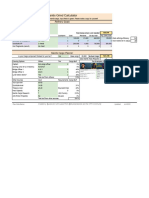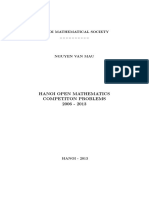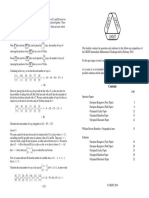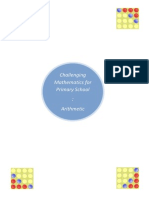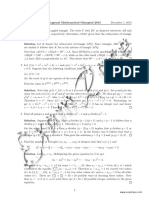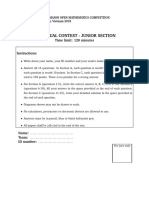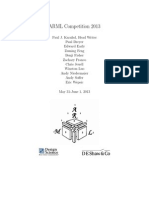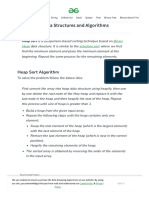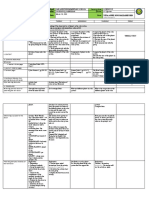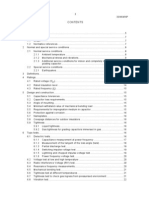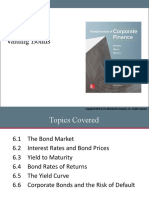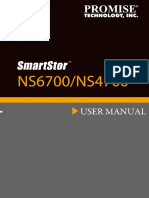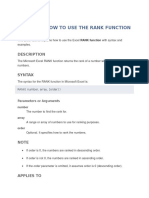De HOMC 2006 2013
De HOMC 2006 2013
Uploaded by
Ba SacCopyright:
Available Formats
De HOMC 2006 2013
De HOMC 2006 2013
Uploaded by
Ba SacOriginal Title
Copyright
Available Formats
Share this document
Did you find this document useful?
Is this content inappropriate?
Copyright:
Available Formats
De HOMC 2006 2013
De HOMC 2006 2013
Uploaded by
Ba SacCopyright:
Available Formats
HANOI MATHEMATICAL SOCIETY
NGUYEN VAN MAU
HANOI OPEN MATHEMATICS
COMPETITON PROBLEMS
2006 - 2013
HANOI - 2013
Contents
1 Hanoi Open Mathematics Competition 3
1.1 Hanoi Open Mathematics Competition 2006 . . . 3
1.1.1 Junior Section . . . . . . . . . . . . . . . . 3
1.1.2 Senior Section . . . . . . . . . . . . . . . . 4
1.2 Hanoi Open Mathematics Competition 2007 . . . 6
1.2.1 Junior Section . . . . . . . . . . . . . . . . 6
1.2.2 Senior Section . . . . . . . . . . . . . . . . 8
1.3 Hanoi Open Mathematics Competition 2008 . . . 10
1.3.1 Junior Section . . . . . . . . . . . . . . . . 10
1.3.2 Senior Section . . . . . . . . . . . . . . . . 11
1.4 Hanoi Open Mathematics Competition 2009 . . . 13
1.4.1 Junior Section . . . . . . . . . . . . . . . . 13
1.4.2 Senior Section . . . . . . . . . . . . . . . . 15
1.5 Hanoi Open Mathematics Competition 2010 . . . 16
1.5.1 Junior Section . . . . . . . . . . . . . . . . 16
1.5.2 Senior Section . . . . . . . . . . . . . . . . 18
1.6 Hanoi Open Mathematics Competition 2011 . . . 19
1.6.1 Junior Section . . . . . . . . . . . . . . . . 19
1.6.2 Senior Section . . . . . . . . . . . . . . . . 21
1.7 Hanoi Open Mathematics Competition 2012 . . . 23
1
1.7.1 Junior Section . . . . . . . . . . . . . . . . 23
1.7.2 Senior Section . . . . . . . . . . . . . . . . 26
1.8 Hanoi Open Mathematics Competition 2013 . . . 28
1.8.1 Junior Section . . . . . . . . . . . . . . . . 28
1.8.2 Senior Section . . . . . . . . . . . . . . . . 31
2
Chapter 1
Hanoi Open Mathematics
Competition
1.1 Hanoi Open Mathematics Competition 2006
1.1.1 Junior Section
Question 1. What is the last two digits of the number
(11 + 12 + 13 + + 2006)
2
?
Question 2. Find the last two digits of the sum
2005
11
+ 2005
12
+ + 2005
2006
.
Question 3. Find the number of dierent positive integer
triples (x, y, z) satisfying the equations
x
2
+ y z = 100 and x + y
2
z = 124.
Question 4. Suppose x and y are two real numbers such that
x + y xy = 155 and x
2
+ y
2
= 325.
Find the value of [x
3
y
3
[.
3
Question 5. Suppose n is a positive integer and 3 arbitrary
numbers are choosen from the set 1, 2, 3, . . . , 3n+1 with their
sum equal to 3n + 1.
What is the largest possible product of those 3 numbers?
Question 6. The gure ABCDEF is a regular hexagon. Find
all points M belonging to the hexagon such that
Area of triangle MAC = Area of triangle MCD.
Question 7. On the circle (O) of radius 15cm are given 2 points
A, B. The altitude OH of the triangle OAB intersect (O) at C.
What is AC if AB = 16cm?
Question 8. In ABC, PQ | BC where P and Q are points
on AB and AC respectively. The lines PC and QB intersect
at G. It is also given EF//BC, where G EF, E AB and
F AC with PQ = a and EF = b. Find value of BC.
Question 9. What is the smallest possible value of
x
2
+ y
2
x y xy?
1.1.2 Senior Section
Question 1. What is the last three digits of the sum
11! + 12! + 13! + + 2006!
Question 2. Find the last three digits of the sum
2005
11
+ 2005
12
+ + 2005
2006
.
Question 3. Suppose that
a
log
b
c
+ b
log
c
a
= m.
4
Find the value of
c
log
b
a
+ a
log
c
b
?
Question 4. Which is larger
2
2
, 2
1+
1
2
and 3.
Question 5. The gure ABCDEF is a regular hexagon. Find
all points M belonging to the hexagon such that
Area of triangle MAC = Area of triangle MCD.
Question 6. On the circle of radius 30cm are given 2 points A,
B with AB = 16cm and C is a midpoint of AB. What is the
perpendicular distance from C to the circle?
Question 7. In ABC, PQ | BC where P and Q are points
on AB and AC respectively. The lines PC and QB intersect
at G. It is also given EF//BC, where G EF, E AB and
F AC with PQ = a and EF = b. Find value of BC.
Question 8. Find all polynomials P(x) such that
P(x) +
_
1
x
_
= x +
1
x
, x ,= 0.
Question 9. Let x, y, z be real numbers such that x
2
+y
2
+z
2
=
1. Find the largest possible value of
[x
3
+ y
3
+ z
3
xyz[?
5
1.2 Hanoi Open Mathematics Competition 2007
1.2.1 Junior Section
Question 1. What is the last two digits of the number
(3 + 7 + 11 + + 2007)
2
?
(A) 01; (B) 11; (C) 23; (D) 37; (E) None of the above.
Question 2. What is largest positive integer n satisfying the
following inequality:
n
2006
< 7
2007
?
(A) 7; (B) 8; (C) 9; (D) 10; (E) 11.
Question 3. Which of the following is a possible number of
diagonals of a convex polygon?
(A) 02; (B) 21; (C) 32; (D) 54; (E) 63.
Question 4. Let m and n denote the number of digits in 2
2007
and 5
2007
when expressed in base 10. What is the sum m + n?
(A) 2004; (B) 2005; (C) 2006; (D) 2007; (E) 2008.
Question 5. Let be given an open interval (; eta) with eta
=
1
2007
. Determine the maximum number of irreducible frac-
tions
a
b
in (; eta) with 1 b 2007?
(A) 1002; (B) 1003; (C) 1004; (D) 1005; (E) 1006.
Question 6. In triangle ABC, BAC = 60
0
, ACB = 90
0
and D is on BC. If AD bisects BAC and CD = 3cm. Then
DB is
(A) 3; (B) 4; (C) 5; (D) 6; (E) 7.
6
Question 7. Nine points, no three of which lie on the same
straight line, are located inside an equilateral triangle of side 4.
Prove that some three of these points are vertices of a triangle
whose area is not greater than
3.
Question 8. Let a, b, c be positive integers. Prove that
(b + c a)
2
(b + c)
2
+ a
2
+
(c + a b)
2
(c + a)
2
+ b
2
+
(a + b c)
2
(a + b)
2
+ c
2
3
5
.
Question 9. A triangle is said to be the Heron triangle if it
has integer sides and integer area. In a Heron triangle, the sides
a, b, c satisfy the equation b = a(a c).
Prove that the triangle is isosceles.
Question 10. Let a, b, c be positive real numbers such that
1
bc
+
1
ca
+
1
ab
1. Prove that
a
bc
+
b
ca
+
c
ab
1.
Question 11. How many possible values are there for the sum
a + b + c + d if a, b, c, d are positive integers and abcd = 2007.
Question 12. Calculate the sum
5
2.7
+
5
7.12
+ +
5
2002.2007
.
Question 13. Let be given triangle ABC. Find all points M
such that area of MAB= area of MAC.
Question 14. How many ordered pairs of integers (x, y) satisfy
the equation
2x
2
+ y
2
+ xy = 2(x + y)?
Question 15. Let p = abc be the 3-digit prime number. Prove
that the equation
ax
2
+ bx + c = 0
has no rational roots.
7
1.2.2 Senior Section
Question 1. What is the last two digits of the number
_
11
2
+ 15
2
+ 19
2
+ + 2007
2
_
2
?
(A) 01; (B) 21; (C) 31; (D) 41; (E) None of the above.
Question 2. Which is largest positive integer n satisfying the
following inequality:
n
2007
> (2007)
n
.
(A) 1; (B) 2; (C) 3; (D) 4; (E) None of the above.
Question 3. Find the number of dierent positive integer
triples (x, y, z) satsfying the equations
x + y z = 1 and x
2
+ y
2
z
2
= 1.
(A) 1; (B) 2; (C) 3; (D) 4; (E) None of the above.
Question 4. List the numbers
2,
3
3, ,
4
4,
5
5 and
6
6 in
order from greatest to least.
Question 5. Suppose that A, B, C, D are points on a circle,
AB is the diameter, CD is perpendicular to AB and meets AB
at E, AB and CD are integers and AE EB =
3.
Find AE?
Question 6. Let P(x) = x
3
+ ax
2
+ bx + 1 and [P(x)[ 1 for
all x such that [x[ 1. Prove that [a[ +[b[ 5.
Question 7. Find all sequences of integers x
1
, x
2
, . . . , x
n
, . . .
such that ij divides x
i
+x
j
for any two distinct positive integers
i and j.
8
Question 8.
Let ABC be an equilateral triangle. For a point M inside
ABC, let D, E, F be the feet of the perpendiculars from M
onto BC, CA, AB, respectively. Find the locus of all such points
M for which FDE is a right angle.
Question 9. Let a
1
, a
2
, . . . , a
2007
be real numbers such that
a
1
+a
2
+ +a
2007
(2007)
2
and a
2
1
+a
2
2
+ +a
2
2007
(2007)
3
1.
Prove that a
k
[2006; 2008] for all k 1, 2, . . . , 2007.
Question 10. What is the smallest possible value of
x
2
+ 2y
2
x 2y xy?
Question 11. Find all polynomials P(x) satisfying the equation
(2x 1)P(x) = (x 1)P(2x), x.
Question 12. Calculate the sum
1
2.7.12
+
1
7.12.17
+ +
1
1997.2002.2007
.
Question 13. Let ABC be an acute-angle triangle with BC >
CA. Let O, H and F be the circumcenter, orthocentre and the
foot of its altitude CH, respectively.
Suppose that the perpendicular to OF at F meet the side
CA at P. Prove FHP = BAC.
Question 14. How many ordered pairs of integers (x, y) satisfy
the equation
x
2
+ y
2
+ xy = 4(x + y)?
9
Question 15. Let p = abcd be the 4-digit prime number. Prove
that the equation
ax
3
+ bx
2
+ cx + d = 0
has no rational roots.
1.3 Hanoi Open Mathematics Competition 2008
1.3.1 Junior Section
Question 1. How many integers from 1 to 2008 have the sum
of their digits divisible by 5 ?
Question 2. How many integers belong to (a, 2008a), where a
(a > 0) is given.
Question 3. Find the coecient of x in the expansion of
(1 + x)(1 2x)(1 + 3x)(1 4x) (1 2008x).
Question 4. Find all pairs (m, n) of positive integers such that
m
2
+ n
2
= 3(m + n).
Question 5. Suppose x, y, z, t are real numbers such that
_
_
[x + y + z t[ 1
[y + z + t x[ 1
[z + t + x y[ 1
[t + x + y z[ 1
Prove that x
2
+ y
2
+ z
2
+ t
2
1.
Question 6. Let P(x) be a polynomial such that
P(x
2
1) = x
4
3x
2
+ 3.
10
Find P(x
2
+ 1)?
Question 7. The gure ABCDE is a convex pentagon. Find
the sum
DAC +EBD +ACE +BDA +CEB?
Question 8. The sides of a rhombus have length a and the area
is S. What is the length of the shorter diagonal?
Question 9. Let be given a right-angled triangle ABC with
A = 90
0
, AB = c, AC = b. Let E AC and F AB
such that AEF = ABC and AFE = ACB. Denote by
P BC and Q BC such that EP BC and FQ BC.
Determine EP + EF + PQ?
Question 10. Let a, b, c [1, 3] and satisfy the following con-
ditions
maxa, b, c 2, a + b + c = 5.
What is the smallest possible value of
a
2
+ b
2
+ c
2
?
1.3.2 Senior Section
Question 1. How many integers are there in (b, 2008b], where
b (b > 0) is given.
Question 2. Find all pairs (m, n) of positive integers such that
m
2
+ 2n
2
= 3(m + 2n).
Question 3. Show that the equation
x
2
+ 8z = 3 + 2y
2
11
has no solutions of positive integers x, y and z.
Question 4. Prove that there exists an innite number of rela-
tively prime pairs (m, n) of positive integers such that the equa-
tion
x
3
nx + mn = 0
has three distint integer roots.
Question 5. Find all polynomials P(x) of degree 1 such that
max
axb
P(x) min
axb
P(x) = b a, a, b R where a < b.
Question 6. Let a, b, c [1, 3] and satisfy the following condi-
tions
maxa, b, c 2, a + b + c = 5.
What is the smallest possible value of
a
2
+ b
2
+ c
2
?
Question 7. Find all triples (a, b, c) of consecutive odd positive
integers such that a < b < c and a
2
+ b
2
+ c
2
is a four digit
number with all digits equal.
Question 8. Consider a convex quadrilateral ABCD. Let O
be the intersection of AC and BD; M, N be the centroid of
AOB and COD and P, Q be orthocenter of BOC and
DOA, respectively. Prove that MN PQ.
Question 9. Consider a triangle ABC. For every point M
BC we dine N CA and P AB such that APMN is a
12
parallelogram. Let O be the intersection of BN and CP. Find
M BC such that PMO = OMN.
Question 10. Let be given a right-angled triangle ABC with
A = 90
0
, AB = c, AC = b. Let E AC and F AB
such that AEF = ABC and AFE = ACB. Denote by
P BC and Q BC such that EP BC and FQ BC.
Determine EP + EF + FQ?
1.4 Hanoi Open Mathematics Competition 2009
1.4.1 Junior Section
Question 1. Let a, b, c be 3 distinct numbers from1, 2, 3, 4, 5, 6.
Show that 7 divides abc + (7 a)(7 b)(7 c).
Question 2. Show that there is a natural number n such that
the number a = n! ends exacly in 2009 zeros.
Question 3. Let a, b, c be positive integers with no common
factor and satisfy the conditions
1
a
+
1
b
=
1
c
.
Prove that a + b is a square.
Question 4. Suppose that a = 2
b
, where b = 2
10n+1
. Prove that
a is divisible by 23 for any positive integer n.
Question 5. Prove that m
7
m is divisible by 42 for any
positive integer m.
13
Question 6. Suppose that 4 real numbers a, b, c, d satisfy the
conditions
_
_
_
a
2
+ b
2
= 4
c
2
+ d
2
= 4
ac + bd = 2
Find the set of all possible values the number M = ab +cd can
take.
Question 7. Let a, b, c, d be positive integers such that a +b +
c + d = 99. Find the smallest and the greatest values of the
following product P = abcd.
Question 8. Find all the pairs of the positive integers such that
the product of the numbers of any pair plus the half of one of
the numbers plus one third of the other number is three times
less than 1004.
Question 9. Let be given ABC with area (ABC) = 60cm
2
.
Let R, S lie in BC such that BR = RS = SC and P, Q be mid-
points of AB and AC, respectively. Suppose that PS intersects
QR at T. Evaluate area (PQT).
Question 10. Let ABC be an acute-angled triangle with AB =
4 and CD be the altitude through C with CD = 3. Find the
distance between the midpoints of AD and BC.
Question 11. Let A = 1, 2, . . . , 100 and B is a subset of A
having 48 elements. Show that B has two distint elements x
and y whose sum is divisible by 11.
14
1.4.2 Senior Section
Question 1. Let a, b, c be 3 distinct numbers from1, 2, 3, 4, 5, 6.
Show that 7 divides abc + (7 a)(7 b)(7 c).
Question 2. Show that there is a natural number n such that
the number a = n! ends exacly in 2009 zeros.
Question 3. Let a, b, c be positive integers with no common
factor and satisfy the conditions
1
a
+
1
b
=
1
c
.
Prove that a + b is a square.
Question 4. Suppose that a = 2
b
, where b = 2
10n+1
. Prove that
a is divisible by 23 for any positive integer n.
Question 5. Prove that m
7
m is divisible by 42 for any
positive integer m.
Question 6. Suppose that 4 real numbers a, b, c, d satisfy the
conditions
_
_
_
a
2
+ b
2
= 4
c
2
+ d
2
= 4
ac + bd = 2
Find the set of all possible values the number M = ab +cd can
take.
Question 7. Let a, b, c, d be positive integers such that a +b +
c + d = 99. Find the smallest and the greatest values of the
following product P = abcd.
15
Question 8. Find all the pairs of the positive integers such that
the product of the numbers of any pair plus the half of one of
the numbers plus one third of the other number is three times
less than 1004.
Question 9.Given an acute-angled triangle ABC with area S,
let points A
/
, B
/
, C
/
be located as follows: A
/
is the point where
altitude from A on BC meets the outwards facing semicirle
drawn on BC as diameter. Points B
/
, C
/
are located similarly.
Evaluate the sum
T = (area BCA
/
)
2
+ (area CAB
/
)
2
+ (area ABC
/
)
2
.
Question 10. Prove that d
2
+(ab)
2
< c
2
, where d is diameter
of the inscribed circle of ABC.
Question 11. Let A = 1, 2, . . . , 100 and B is a subset of A
having 48 elements. Show that B has two distint elements x
and y whose sum is divisible by 11.
1.5 Hanoi Open Mathematics Competition 2010
1.5.1 Junior Section
Question 1. Compare the numbers:
P = 888 . . . 888
. .
2010 digits
333 . . . 333
. .
2010 digits
and Q = 444 . . . 444
. .
2010 digits
666 . . . 667
. .
2010 digits
(A): P = Q; (B): P > Q; (C): P < Q.
Question 2. The number of integer n from the set 2000, 2001, . . . , 2010
such that 2
2n
+ 2
n
+ 5 is divisible by 7:
16
(A): 0; (B): 1; (C): 2; (D): 3; (E) None of the above.
Question 3. 5 last digits of the number M = 5
2010
are
(A): 65625; (B): 45625; (C): 25625; (D): 15625; (E) None of the
above.
Question 4. How many real numbers a (1, 9) such that the
corresponding number a
1
a
is an integer.
(A): 0; (B): 1; (C): 8; (D): 9; (E) None of the above.
Question 5. Each box in a 2 2 table can be colored black or
white. How many dierent colorings of the table are there?
(A): 4; (B): 8; (C): 16; (D): 32; (E) None of the above.
Question 6. The greatest integer less than (2 +
3)
5
are
(A): 721; (B): 722; (C): 723; (D): 724; (E) None of the above.
Question 7. Determine all positive integer a such that the
equation
2x
2
30x + a = 0
has two prime roots, i.e. both roots are prime numbers.
Question 8. If n and n
3
+2n
2
+2n+4 are both perfect squares,
nd n.
Question 9. Let be given a triangle ABC and points D, M, N
belong to BC, AB, AC, respectively. Suppose that MD is par-
allel to AC and ND is parallel to AB. If S
BMD
= 9cm
2
,
S
DNC
= 25cm
2
, compute S
AMN
?
17
Question 10. Find the maximum value of
M =
x
2x + y
+
y
2y + z
+
z
2z + x
, x, y, z > 0.
1.5.2 Senior Section
Question 1. The number of integers n [2000, 2010] such that
2
2n
+ 2
n
+ 5 is divisible by 7 is
(A): 0; (B): 1; (C): 2; (D): 3; (E) None of the above.
Question 2. 5 last digits of the number 5
2010
are
(A): 65625; (B): 45625; (C): 25625; (D): 15625; (E) None of the
above.
Question 3. How many real numbers a (1, 9) such that the
corresponding number a
1
a
is an integer.
(A): 0; (B): 1; (C): 8; (D): 9; (E) None of the above.
Question 4. Each box in a 2 2 table can be colored black or
white. How many dierent colorings of the table are there?
Question 5. Determine all positive integer a such that the
equation
2x
2
30x + a = 0
has two prime roots, i.e. both roots are prime numbers.
Question 6. Let a, b be the roots of the equation x
2
px+q = 0
and let c, d be the roots of the equation x
2
rx + s = 0, where
p, q, r, s are some positive real numbers. Suppose that
M =
2(abc + bcd + cda + dab)
p
2
+ q
2
+ r
2
+ s
2
18
is an integer. Determine a, b, c, d.
Question 7. Let P be the common point of 3 internal bisectors
of a given ABC. The line passing through P and perpendicular
to CP intersects AC and BC at M and N, respectively. If
AP = 3cm, BP = 4cm, compute the value of
AM
BN
?
Question 8. If n and n
3
+2n
2
+2n+4 are both perfect squares,
nd n.
Question 9. Let x, y be the positive integers such that 3x
2
+
x = 4y
2
+ y. Prove that x y is a perfect integer.
Question 10. Find the maximum value of
M =
x
2x + y
+
y
2y + z
+
z
2z + x
, x, y, z > 0.
1.6 Hanoi Open Mathematics Competition 2011
1.6.1 Junior Section
Question 1. Three lines are drawn in a plane. Which of the
following could NOT be the total number of points of intersec-
tions?
(A): 0; (B): 1; (C): 2; (D): 3; (E): They all could.
Question 2. The last digit of the number A = 7
2011
is
(A) 1; (B) 3; (C) 7; (D) 9; (E) None of the above.
Question 3. What is the largest integer less than or equal to
19
3
_
(2011)
3
+ 3 (2011)
2
+ 4 2011 + 5?
(A) 2010; (B) 2011; (C) 2012; (D) 2013; (E) None of the
above.
Question 4. Among the four statements on real numbers be-
low, how many of them are correct?
If a < b < 0 then a < b
2
;
If 0 < a < b then a < b
2
;
If a
3
< b
3
then a < b;
If a
2
< b
2
then a < b;
If [a[ < [b[ then a < b.
(A) 0; (B) 1; (C) 2; (D) 3; (E) 4
Question 5. Let M = 7! 8! 9! 10! 11! 12!. How many
factors of M are perfect squares?
Question 6.Find all positive integers (m, n) such that
m
2
+ n
2
+ 3 = 4(m + n).
Question 7. Find all pairs (x, y) of real numbers satisfying the
system
_
x + y = 3
x
4
y
4
= 8x y
Question 8. Find the minimum value of
S = [x + 1[ +[x + 5[ +[x + 14[ +[x + 97[ +[x + 1920[.
20
Question 9. Solve the equation
1 + x + x
2
+ x
3
+ + x
2011
= 0.
Question 10. Consider a right-angle triangle ABC with A =
90
o
, AB = c and AC = b. Let P AC and Q AB such that
APQ = ABC and AQP = ACB. Calculate PQ + PE +
QF, where E and F are the projections of P and Q onto BC,
respectively.
Question 11. Given a quadrilateral ABCD with AB = BC =
3cm, CD = 4cm, DA = 8cm and DAB + ABC = 180
o
.
Calculate the area of the quadrilateral.
Question 12. Suppose that a > 0, b > 0 and a + b 1.
Determine the minimum value of
M =
1
ab
+
1
a
2
+ ab
+
1
ab + b
2
+
1
a
2
+ b
2
.
1.6.2 Senior Section
Question 1. An integer is called octal if it is divisible by 8
or if at least one of its digits is 8. How many integers between
1 and 100 are octal?
(A): 22; (B): 24; (C): 27; (D): 30; (E): 33.
Question 2. What is the smallest number
(A) 3; (B) 2
2
; (C) 2
1+
1
2
; (D) 2
1
2
+ 2
2
3
; (E) 2
5
3
.
Question 3. What is the largest integer less than to
3
_
(2011)
3
+ 3 (2011)
2
+ 4 2011 + 5?
21
(A) 2010; (B) 2011; (C) 2012; (D) 2013; (E) None of the
above.
Question 4. Prove that
1 + x + x
2
+ x
3
+ + x
2011
0
for every x 1.
Question 5. Let a, b, c be positive integers such that a + 2b +
3c = 100. Find the greatest value of M = abc.
Question 6. Find all pairs (x, y) of real numbers satisfying the
system
_
x + y = 2
x
4
y
4
= 5x 3y
Question 7. How many positive integers a less than 100 such
that 4a
2
+ 3a + 5 is divisible by 6.
Question 8. Find the minimum value of
S = [x + 1[ +[x + 5[ +[x + 14[ +[x + 97[ +[x + 1920[.
Question 9. For every pair of positive integers (x; y) we dene
f(x; y) as follows:
f(x, 1) = x
f(x, y) = 0 if y > x
f(x + 1, y) = y[f(x, y) + f(x, y 1)]
Evaluate f(5; 5).
22
Question 10. Two bisectors BD and CE of the triangle ABC
intersect at O. Suppose that BD.CE = 2BO.OC. Denote by H
the point in BC such that OH BC. Prove that AB.AC =
2HB.HC.
Question 11. Consider a right-angle triangle ABC with A =
90
o
, AB = c and AC = b. Let P AC and Q AB such that
APQ = ABC and AQP = ACB. Calculate PQ + PE +
QF, where E and F are the projections of P and Q onto BC,
respectively.
Question 12. Suppose that [ax
2
+bx+c[ [x
2
1[ for all real
numbers x. Prove that [b
2
4ac[ 4.
1.7 Hanoi Open Mathematics Competition 2012
1.7.1 Junior Section
Question 1. Assume that a b = (a b). Then:
(A) a = b; (B) a < b; (C) a > b; (D); It is impos-
sible to compare those of a and b.
Question 2. Let be given a parallelogram ABCD with the
area of 12cm
2
. The line through A and the midpoint M of BC
meets BD at N. Compute the area of the quadrilateral MNDC.
(A): 4cm
2
; (B): 5cm
2
; (C): 6cm
2
; (D): 7cm
2
; (E) None of the above.
Question 3. For any possitive integer a, let [a] denote the
smallest prime factor of a. Which of the following numbers is
equal to [35]?
(A) [10]; (B) [15]; (C) [45]; (D) [55]; (E) [75];
23
Question 4. A man travels from town A to town E through
towns B, C and D with uniform speeds 3km/h, 2km/h, 6km/h
and 3km/h on the horizontal, up slope, down slope and hori-
zontal road, respectively. If the road between town A and town
E can be classied as horizontal, up slope, down slope and hor-
izontal and total length of each type of road is the same, what
is the average speed of his journey?
(A) 2km/h; (B) 2,5km/h; (C) 3km/h; (D) 3,5km/h; (E)
4km/h.
24
Question 5. How many dierent 4-digit even integers can be
form from the elements of the set 1, 2, 3, 4, 5.
(A): 4; (B): 5; (C): 8; (D): 9; (E) None of the above.
Question 6. At 3:00 A.M. the temperature was 13
o
below zero.
By noon it had risen to 32
o
. What is the average hourly increase
in teparature?
Question 7. Find all integers n such that 60 + 2n n
2
is a
perfect square.
Question 8. Given a triangle ABC and 2 points K AB,
N BC such that BK = 2AK, CN = 2BN and Q is the
common point of AN and CK. Compute
S
ABC
S
BCQ
Question 9. Evaluate the integer part of the number
H =
_
1 + 2011
2
+
2011
2
2012
2
+
2011
2012
Question 10. Solve the following equation
1
(x + 29)
2
+
1
(x + 30)
2
=
13
36
Question 11. Let be given a sequence a
1
= 5, a
2
= 8 and
a
n+1
= a
n
+3a
n1
, n = 2, 3, . . . . Calculate the greatest common
divisor of a
2011
and a
2012
.
Question 12. Find all positive integers P such that the sum
and product of all its divisors are 2P and P
2
, respectively.
Question 13. Determine the greatest value of the sum M =
11xy + 3xz + 2012yz, where x, y, z are non negative integers
satisfying the following condition x + y + z = 1000.
25
Question 14. Let be given a triangle ABC with A = 90
0
and the bisectrices of angles B and C meet at I. Suppose that
IH is perpendicular to BC (H belongs to BC). If HB = 5cm,
HC = 8cm, compute the area of ABC.
Question 15. Determine the greatest value of the sum M =
xy + yz + zx, where x, y, z are real numbers satisfying the fol-
lowing condition x
2
+ 2y
2
+ 5z
2
= 22.
1.7.2 Senior Section
Question 1. Let x =
_
6 + 2
5 +
_
6 2
20
The value of
H = (1 + x
5
x
7
)
2012
3
11
is
(A): 1; (B): 11; (C): 21; (D): 101; (E) None of the above.
Question 2. Compare the numbers:
P = 2
, Q = 3, T = 2
, where =
2, = 1 +
1
2
(A): P < Q < T; (B): T < P < Q; (C): P < T < Q; (D):
T < Q < P; (E): Q < P < T.
Question 3. Let be given a trapezoidal ABCD with the based
edges BC = 3cm, DA = 6cm (AD | BC). Then the length of
the line EF (E AB, F CD and EF | AD) through the
common point M of AC and BD is
(A): 3,5cm; (B): 4cm; (C): 4,5cm; (D): 5cm; (E) None of the
above.
Question 4. What is the largest integer less than or equal to
4x
3
3x, where x =
1
2
_
3
_
2 +
3 +
3
_
2
3
_
?
26
(A): 1; (B): 2; (C): 3; (D): 4; (E) None of the above.
Question 5. Let f(x) be a function such that f(x)+2f
_
x + 2010
x 1
_
=
4020 x for all x ,= 1. Then the value of f(2012) is
(A): 2010; (B): 2011; (C): 2012; (D): 2014; (E) None of the
above.
Question 6. For every n = 2, 3, . . . , we put
A
n
=
_
1
1
1 + 2
_
_
1
1
1 + 2 + 3
_
_
1
1
1 + 2 + 3 + + n
_
.
Determine all positive integer n (n 2) such that
1
A
n
is an
integer.
Question 7. Prove that the number a = 1 . . . 1
. .
2012
5 . . . 5
. .
2011
6 is a
perfect square.
Question 8. Determine the greatest number m such that the
system
_
x
2
+ y
2
= 1
[x
3
y
3
[ +[x y[ = m
3
has a solution.
Question 9. Let P be the common point of 3 internal bisectors
of a given ABC. The line passing through P and perpendicular
to CP intersects AC and BC at M and N, respectively. If
AP = 3cm, BP = 4cm, compute the value of
AM
BN
?
Question 10. Suppose that the equation x
3
+px
2
+qx+1 = 0,
with p, q are rational numbers, has 3 real roots x
1
, x
2
, x
3
, where
x
3
= 2 +
5, compute the values of p and q?
27
Question 11. Suppose that the equation x
3
+px
2
+qx+r = 0
has 3 real roots x
1
, x
2
, x
3
, where p, q, r are integer numbers. Put
S
n
= x
n
1
+ x
n
2
+ x
n
3
, n = 1, 2, . . . Prove that S
2012
is an integer.
Question 12. In an isosceles triangle ABC with the base AB
given a point M BC. Let O be the center of its circumscribed
circle and S be the center of the inscribed circle in ABC and
SM | AC. Prove that OM BS.
Question 13. A cube with sides of length 3cm is painted red
and then cut into 3 3 3 = 27 cubes with sides of length 1cm.
If a denotes the number of small cubes (of 1cm1cm1cm) that
are not painted at all, b the number painted on one sides, c the
number painted on two sides, and d the number painted on three
sides, determine the value a b c + d?
Question 14. Solve, in integers, the equation 16x + 1 = (x
2
y
2
)
2
.
Question 15. Determine the smallest value of the sum M =
xy yz zx, where x, y, z are real numbers satisfying the fol-
lowing condition x
2
+ 2y
2
+ 5z
2
= 22.
1.8 Hanoi Open Mathematics Competition 2013
1.8.1 Junior Section
Question 1. Write 2013 as a sum of m prime numbers. The
smallest value of m is:
(A): 2; (B): 3; (C): 4; (D): 1; (E): None of the above.
28
Question 2. How many natural numbers n are there so that
n
2
+ 2014 is a perfect square.
(A): 1; (B): 2; (C): 3; (D): 4; (E) None of the above.
Question 3. The largest integer not exceeding [(n+1)] [n],
where n is a natural number, =
2013
2014
, is:
(A): 1; (B): 2; (C): 3; (D): 4; (E) None of the above.
Question 4. Let A be an even number but not divisible by 10.
The last two digits of A
20
are:
(A): 46; (B): 56; (C): 66; (D): 76; (E): None of the
above.
Question 5. The number of integer solutions x of the equation
below
(12x 1)(6x 1)(4x 1)(3x 1) = 330.
is: (A): 0; (B): 1; (C): 2; (D): 3; (E): None of the above.
Short Questions
Question 6. Let ABC be a triangle with area 1 (cm
2
). Points
D, E and F lie on the sides AB, BC and CA, respectively. Prove
that
minArea of ADF, Area of BED, Area of CEF
1
4
(cm
2
).
29
Question 7. Let ABC be a triangle with
A = 90
0
,
B = 60
0
and
BC = 1cm. Draw outside of ABC three equilateral triangles
ABD, ACE and BCF. Determine the area of DEF.
Question 8. Let ABCDE be a convex pentagon. Given that
area of ABC = area of BCD = area of CDE
= area of DEA = area of EAB = 2cm
2
,
Find the area of the pentagon.
Question 9. Solve the following system in positive numbers
_
_
_
x + y 1
2
xy
+
1
x
2
+ y
2
= 10.
Question 10. Consider the set of all rectangles with a given
perimeter p. Find the largest value of
M =
S
2S + p + 2
,
where S is denoted the area of the rectangle.
Question 11. The positive numbers a, b, c, d, e are such that
the following identity hold for all real number x.
(x + a)(x + b)(x + c) = x
3
+ 3dx
2
+ 3x + e
3
.
Find the smallest value of d.
Question 12. If f(x) = ax
2
+ bx + c sases the condition
[f(x)[ < 1, x [1, 1],
30
prove that the equation f(x) = 2x
2
1 has two real roots.
Question 13. Solve the system of equations
_
_
1
x
+
1
y
=
1
6
3
x
+
2
y
=
5
6
Question 14. Solve the system of equations
_
_
_
x
3
+ y = x
2
+ 1
2y
3
+ z = 2y
2
+ 1
3z
3
+ x = 3z
2
+ 1
Question 15. Denote by Q and N
the set of all rational and
positive integer numbers, respectively. Suppose that
ax + b
x
Q
for every x N
. Prove that there exist integers A, B, C such
that
ax + b
x
=
Ax + B
Cx
for all x N
.
1.8.2 Senior Section
Question 1. How many three-digit perfect squares are there
such that if each digit is increased by one, the resulting number
is also a perfect square?
(A): 1; (B): 2; (C): 4; (D): 8; (E) None of the above.
Question 2. The smallest value of the function
f(x) = [x[ +
1 2013x
2013 x
where x [1, 1] is
31
(A):
1
2012
; (B):
1
2013
; (C):
1
2014
; (D):
1
2015
; (E): None
of the above.
Question 3. What is the largest integer not exceeding 8x
3
+
6x 1, where x =
1
2
_
3
_
2 +
5 +
3
_
2
5
_
?
(A): 1; (B): 2; (C): 3; (D): 4; (E) None of the above.
Question 4. Let x
0
= [], x
1
= [2] [], x
2
= [3] [2],
x
4
= [5] [4], x
5
= [6] [5], . . . , where =
2013
2014
. The
value of x
9
is
(A): 2; (B): 3; (C): 4; (D): 5; (E): None of the above.
Question 5. The number n is called a composite number if it
can be written in the form n = a b, where a, b are positive
integers greater than 1.
Write number 2013 in a sum of m composite numbers. What
is the largest value of m?
(A): 500; (B): 501; (C): 502; (D): 503; (E): None of the
above.
Question 6. Let be given a 0, 1, 2, 3, . . . , 1006. Find all
n 0, 1, 2, 3, . . . , 2013 such that C
n
2013
> C
a
2013
, where C
k
m
=
m!
k!(mk)!
.
Question 7. Let ABC be an equilateral triangle and a point
M inside the triangle such that MA
2
= MB
2
+MC
2
. Draw an
equilateral triangle ACD where D ,= B. Let the point N inside
32
ACD such that AMN is an equilateral triangle. Determine
BMC.
Question 8. Let ABCDE be a convex pentagon and
area of ABC = area of BCD = area of CDE
= area of DEA = area of EAB.
Given that area of ABCDE = 2. Evaluate the area of area of ABC.
Question 9. A given polynomial P(t) = t
3
+at
2
+bt +c has 3
distinct real roots. If the equation (x
2
+x+2013)
3
+a(x
2
+x+
2013)
2
+ b(x
2
+ x + 2013) + c = 0 has no real roots, prove that
P(2013) >
1
64
.
Question 10. Consider the set of all rectangles with a given
area S. Find the largest value of
M =
16S p
p
2
+ 2p
,
where p is the perimeter of the rectangle.
Question 11. The positive numbers a, b, c, d, p, q are such that
(x+a)(x+b)(x+c)(x+d) = x
4
+4px
3
+6x
2
+4qx+1 holds for all real numbers x.
Find the smallest value of p or the largest value of q.
Question 12. The function f(x) = ax
2
+ bx + c sases the
following conditions: f(
2) = 3, and
[f(x)[ 1, for all x [1, 1].
33
Evaluate the value of f(
2013).
Question 13. Solve the system of equations
_
xy = 1
x
x
4
+ y
2
+
y
x
2
+ y
4
= 1
Question 14. Solve the system of equations:
_
_
x
3
+
1
3
y = x
2
+ x
4
3
y
3
+
1
4
z = y
2
+ y
5
4
z
3
+
1
5
x = z
2
+ z
6
5
Question 15. Denote by Q and N
the set of all rational and
positive integral numbers, respectively. Suppose that
ax + b
cx + d
Q for every x N
. Prove that there exist integers A, B, C, D
such that
ax + b
cx + d
=
Ax + B
Cx + D
for all x N
.
-
34
You might also like
- English Grammar For Students of Italian - The Study Guide For Those Learning ItalianDocument212 pagesEnglish Grammar For Students of Italian - The Study Guide For Those Learning ItalianvictorhugomarianosiNo ratings yet
- STFC - Mantis InformationDocument8 pagesSTFC - Mantis InformationJason MillerNo ratings yet
- Renryuu Ascension - WalkthroughDocument174 pagesRenryuu Ascension - WalkthroughJuanky HoHNo ratings yet
- Timetables and Distance TablesDocument11 pagesTimetables and Distance TablesJoel GrayNo ratings yet
- Junior Mathematical Challenge: Tuesday 30 April 2019Document4 pagesJunior Mathematical Challenge: Tuesday 30 April 2019Add UpNo ratings yet
- De Thu Va Loi Giai HOMC 2006 - 2016Document77 pagesDe Thu Va Loi Giai HOMC 2006 - 2016Nguyễn Kim Chuẩn81% (16)
- Hanoi Open Mathematical Olympiad 2006-2009Document16 pagesHanoi Open Mathematical Olympiad 2006-2009Pasharapon PongpattanakitNo ratings yet
- IMOK Booklet 2010Document20 pagesIMOK Booklet 2010Mehrdad AbutalebiNo ratings yet
- 2001Gauss7Solution PDFDocument10 pages2001Gauss7Solution PDFkarpeoNo ratings yet
- 2010 Maths PDFDocument23 pages2010 Maths PDFalmond2009No ratings yet
- Kangoeroe WizBRAIN 2015 EngelsDocument5 pagesKangoeroe WizBRAIN 2015 EngelserikatsmaNo ratings yet
- China China Girls Math Olympiad 2008Document2 pagesChina China Girls Math Olympiad 2008PremMehtaNo ratings yet
- BulgarianMathematicalCompetitions2003 2006 PDFDocument221 pagesBulgarianMathematicalCompetitions2003 2006 PDFĐặng Quốc ThànhNo ratings yet
- Intermediate Mathematical Challenge: InstructionsDocument4 pagesIntermediate Mathematical Challenge: InstructionsdanielshiNo ratings yet
- Primary Math Challenge ArithmeticDocument28 pagesPrimary Math Challenge ArithmeticSadi SnmzNo ratings yet
- Mock AMC BDocument4 pagesMock AMC Beisatopon100% (1)
- AlgebraDocument8 pagesAlgebraCambridgeSchool NoidaNo ratings yet
- Third Round 1997 - 2010Document49 pagesThird Round 1997 - 2010Cristian MateiNo ratings yet
- 2015 Gauss SolutionDocument18 pages2015 Gauss Solutionscribd-in-actionNo ratings yet
- 88 Kangaroo PK 2005 BenjaminDocument4 pages88 Kangaroo PK 2005 BenjaminSJK(C) THUNG HONNo ratings yet
- 2002 Gauss 8 SolutionDocument10 pages2002 Gauss 8 Solutionscribd-in-actionNo ratings yet
- Pre-Preparation Course Exam 2004-08 PDFDocument80 pagesPre-Preparation Course Exam 2004-08 PDFSoma BoseNo ratings yet
- 2015 Junior Balkan MO: Contributors: Sayan, NeverloseDocument2 pages2015 Junior Balkan MO: Contributors: Sayan, NeverloseJansen Ken Pregasio IPH StudentNo ratings yet
- UKJ M C: Ukmt Unior Athematical HallengeDocument4 pagesUKJ M C: Ukmt Unior Athematical HallengeHumaira MohungooNo ratings yet
- Prime FactorialDocument2 pagesPrime Factorialayu7kajiNo ratings yet
- THE OLYMPIAD CORNER - Canadian Mathematical Society (PDFDrive) PDFDocument64 pagesTHE OLYMPIAD CORNER - Canadian Mathematical Society (PDFDrive) PDFFustei BogdanNo ratings yet
- Gauss Contest: Grade 7Document68 pagesGauss Contest: Grade 7Ludwing Sierra100% (1)
- Geometry (Volume of Composite Figure/Surfece Area)Document10 pagesGeometry (Volume of Composite Figure/Surfece Area)Erwin ElloNo ratings yet
- Kol PreRmo - 2015 - Nov - 22 - 2015 - UDocument3 pagesKol PreRmo - 2015 - Nov - 22 - 2015 - UHimansu MookherjeeNo ratings yet
- IMOK Booklet 2008Document22 pagesIMOK Booklet 2008Mehrdad AbutalebiNo ratings yet
- Euclid Combined Contest (CMC)Document95 pagesEuclid Combined Contest (CMC)Eric MooiNo ratings yet
- Copernicus 4th Math - Global Round Category 4 - English VerDocument7 pagesCopernicus 4th Math - Global Round Category 4 - English Vervy2b2549jtNo ratings yet
- Ecolier 2008 EnglishDocument4 pagesEcolier 2008 EnglishMuhammad Zaheer AnwarNo ratings yet
- Area ProblemsDocument3 pagesArea ProblemsCambridgeSchool NoidaNo ratings yet
- Izzy Mock MathcountsDocument14 pagesIzzy Mock MathcountsasadNo ratings yet
- Question Booklet: Inter-School Mathematics Contest 2017 - Individual Event (Junior Section)Document9 pagesQuestion Booklet: Inter-School Mathematics Contest 2017 - Individual Event (Junior Section)Imam SyafiiNo ratings yet
- Intermediate Mathematical Challenge 2008Document24 pagesIntermediate Mathematical Challenge 2008Manan RastogiNo ratings yet
- 2012 GR 0708 eDocument5 pages2012 GR 0708 ePei JingNo ratings yet
- Subject: Mathematics Olympiad Assignment 2Document1 pageSubject: Mathematics Olympiad Assignment 2Arpit GargNo ratings yet
- SMOPS Mock 1 SolutionDocument19 pagesSMOPS Mock 1 SolutionMarilyn CitadelNo ratings yet
- 2023 State Competition Solutions - 0Document10 pages2023 State Competition Solutions - 0Daniel BoenfieNo ratings yet
- Build-Up Your Understanding 1Document16 pagesBuild-Up Your Understanding 1NadiaNo ratings yet
- SMO Senior 2013 Round 1Document7 pagesSMO Senior 2013 Round 1gauss202No ratings yet
- JBMO ShortLists-2006Document1 pageJBMO ShortLists-2006OklaNo ratings yet
- RMO Solved PaperDocument8 pagesRMO Solved PaperAbhishek SinghNo ratings yet
- 2012 Euclid SolutionDocument15 pages2012 Euclid SolutionleeaccountNo ratings yet
- 2006 MK Sample Questions NEWDocument12 pages2006 MK Sample Questions NEWSai Sunil ChandraaNo ratings yet
- Senior Section - First Round - SMO Singapore Mathematical Olympiad 2015Document7 pagesSenior Section - First Round - SMO Singapore Mathematical Olympiad 2015Steven RadityaNo ratings yet
- Homc2018 Individual JuniorDocument10 pagesHomc2018 Individual JuniorSon PhamNo ratings yet
- New Zealand Mathematical Olympiad Committee Camp Selection Problems 2011 - InstructionsDocument4 pagesNew Zealand Mathematical Olympiad Committee Camp Selection Problems 2011 - InstructionsRusdin La EbaNo ratings yet
- Pre RMODocument3 pagesPre RMODhrubajyoti Ghosh100% (1)
- PRMO2016 Answers PDFDocument3 pagesPRMO2016 Answers PDFNimai RoyNo ratings yet
- ITA ABooklet 2005Document13 pagesITA ABooklet 2005Vicente TorresNo ratings yet
- JMC11Document2 pagesJMC11aa27965No ratings yet
- 2013 Contest Final VersionDocument38 pages2013 Contest Final VersionQuang Đào VũNo ratings yet
- Jmo 1998Document3 pagesJmo 1998Dr Shyam Sundar AgrawalNo ratings yet
- SMO Junior Mock Paper (2022) - ProblemsDocument6 pagesSMO Junior Mock Paper (2022) - ProblemsYHSNo ratings yet
- HANOI_MATHEMATICAL_SOCIETY_ContentsDocument35 pagesHANOI_MATHEMATICAL_SOCIETY_Contentsnguyenbanhatthienvinh18No ratings yet
- HOMCproblem&solution 2006 2016 PDFDocument77 pagesHOMCproblem&solution 2006 2016 PDFThyeadi Tungson100% (1)
- Hanoi Open Mathematical Olympiad ProblemsDocument23 pagesHanoi Open Mathematical Olympiad ProblemsNehaNo ratings yet
- Homc 2015-2017Document78 pagesHomc 2015-2017Kanchit Saeho80% (5)
- mt3 2Document30 pagesmt3 2Guilherme RochaNo ratings yet
- Poly Teachers Level 2Document2 pagesPoly Teachers Level 2Koushal SharmaNo ratings yet
- Gps Tracker FinalDocument25 pagesGps Tracker FinalRakesh Gupta83No ratings yet
- 0580 s12 QP 22Document12 pages0580 s12 QP 22Aryan RajputNo ratings yet
- Chapra Central School Summer Vacation Homework 2015Document6 pagesChapra Central School Summer Vacation Homework 2015hokavulewis2100% (1)
- Notulen Presentasi Kelompok 3 - PGG2021 - KelasADocument3 pagesNotulen Presentasi Kelompok 3 - PGG2021 - KelasAJauza OcaNo ratings yet
- Cheers and Tears - Lana LaLandDocument52 pagesCheers and Tears - Lana LaLandtrumpcoke02No ratings yet
- Non-Equity and Equity Entry Modes To A Foreign MarketDocument30 pagesNon-Equity and Equity Entry Modes To A Foreign MarketMrunmae HavalNo ratings yet
- Burma (Myanmar Presentation)Document26 pagesBurma (Myanmar Presentation)Sa Sai Noah100% (1)
- O (T - COND (T) ) : Name 'Tina'Document5 pagesO (T - COND (T) ) : Name 'Tina'Anjana MagantiNo ratings yet
- HomeDesignTrendsVol3No2 PDFDocument158 pagesHomeDesignTrendsVol3No2 PDFAngel Velez100% (1)
- Heap Sort - Data Structures and Algorithms Tutorials - GeeksforGeeksDocument2 pagesHeap Sort - Data Structures and Algorithms Tutorials - GeeksforGeekslongphiycNo ratings yet
- Science 6 2019Document531 pagesScience 6 2019jocelyn q. cabrillasNo ratings yet
- Overview Of: Relationship MarketingDocument17 pagesOverview Of: Relationship MarketingFernandes RudolfNo ratings yet
- XRP ExchangesDocument2 pagesXRP ExchangesGaindesec snNo ratings yet
- IEC 62146 Power Capacitors in AC High Volatge CB With 62271-100Document30 pagesIEC 62146 Power Capacitors in AC High Volatge CB With 62271-100Rohit DeraNo ratings yet
- Basic NumberDocument14 pagesBasic Numbersasmi.pasikkuhannadigeNo ratings yet
- Annual Premium Statement: Naresh KumarDocument1 pageAnnual Premium Statement: Naresh Kumarnaresh29122No ratings yet
- Troubleshooting Guide: Electropneumatic PositionersDocument73 pagesTroubleshooting Guide: Electropneumatic Positionersloli2323No ratings yet
- Brealey9eIPPTCh06 Valuing BondsDocument41 pagesBrealey9eIPPTCh06 Valuing BondsTutku YapıcıNo ratings yet
- NSx700 Manual (1.0)Document157 pagesNSx700 Manual (1.0)afeeshNo ratings yet
- Turkish Miniature ArtDocument5 pagesTurkish Miniature ArtŞeref Azim CebeciNo ratings yet
- Grade 9 Math W3 LASDocument16 pagesGrade 9 Math W3 LASDondon TayabanNo ratings yet
- Chamod PaperDocument5 pagesChamod PaperThiranka AriyarathnaNo ratings yet
- Unit 2 EEEDocument185 pagesUnit 2 EEEDevendra BansalNo ratings yet
- Ms Excel:: How To Use The Rank Function (WS)Document5 pagesMs Excel:: How To Use The Rank Function (WS)Hazel Mjkristell Basallote FranceNo ratings yet
- Strategic Management of TechnologyDocument21 pagesStrategic Management of TechnologySuresh Kumar TannanNo ratings yet
- 4 - Conditional Sentences (Ty 1,2,3)Document5 pages4 - Conditional Sentences (Ty 1,2,3)giang nguyenNo ratings yet
- Soal UTS GBK 2017 B. Inggris Kelas XII SMK It Baitun Nur PunggurDocument6 pagesSoal UTS GBK 2017 B. Inggris Kelas XII SMK It Baitun Nur Punggurtoya bikers100% (1)

